The Camphor Tree (Cinnamomum camphora or Camphor laurel) is both magnificent and contentious, and this guide will tell you everything you need to know abot growing and caring for them. These trees stay green year long, provide plenty of shade, emit a fragrant minty smell and are just one of those trees you want to go up and give a good hug. The tree can grow up to 100 feet tall and has glossy, dark green leaves. The camphor tree is known for its strong, pungent aroma, which comes from the essential oil found in its wood and leaves. According to this oil profile, camphor oil is used in a variety of products, including soaps, perfumes, and medicinal ointments.
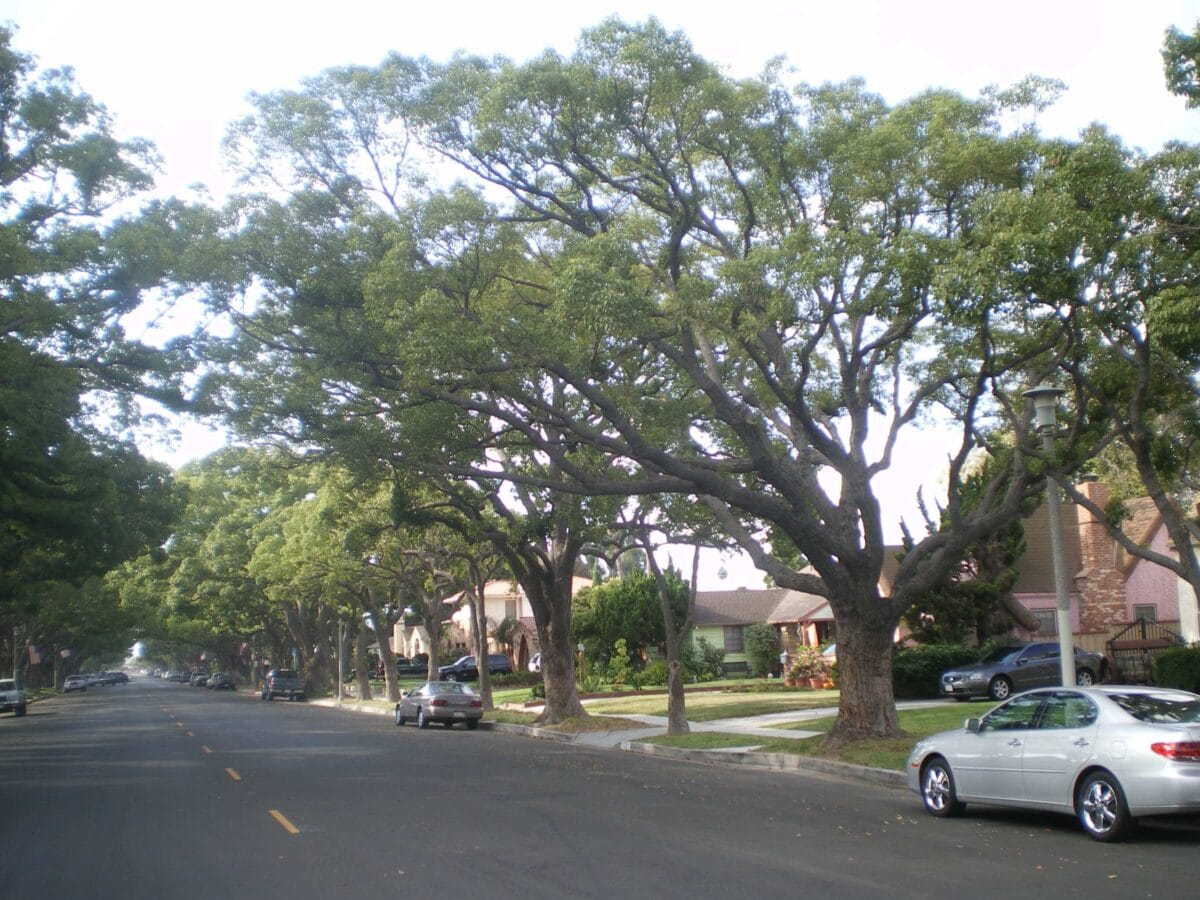
Now, I’ll admit that these camphor trees have a lot going against them. They are invasive to some parts of the U.S., spread like crazy, are not the most sturdy trees, are susceptible to disease, and their long roots can do serious damage to sidewalks and septic tanks. Given the right setting and owner, however, the camphor can become a wonderfully beautiful shade tree for those willing to put in the effort.
Is a Camphor Tree not for you? Take a look at these beautiful Dogwood Trees instead!
The Camphor tree is an evergreen tree in the Laurel family, and is native to Asia where they are often grown commercially for harvesting camphor oil. They have shiny, elliptical leaves that are light-bright green when first sprouted, and then turn a deep green when older.
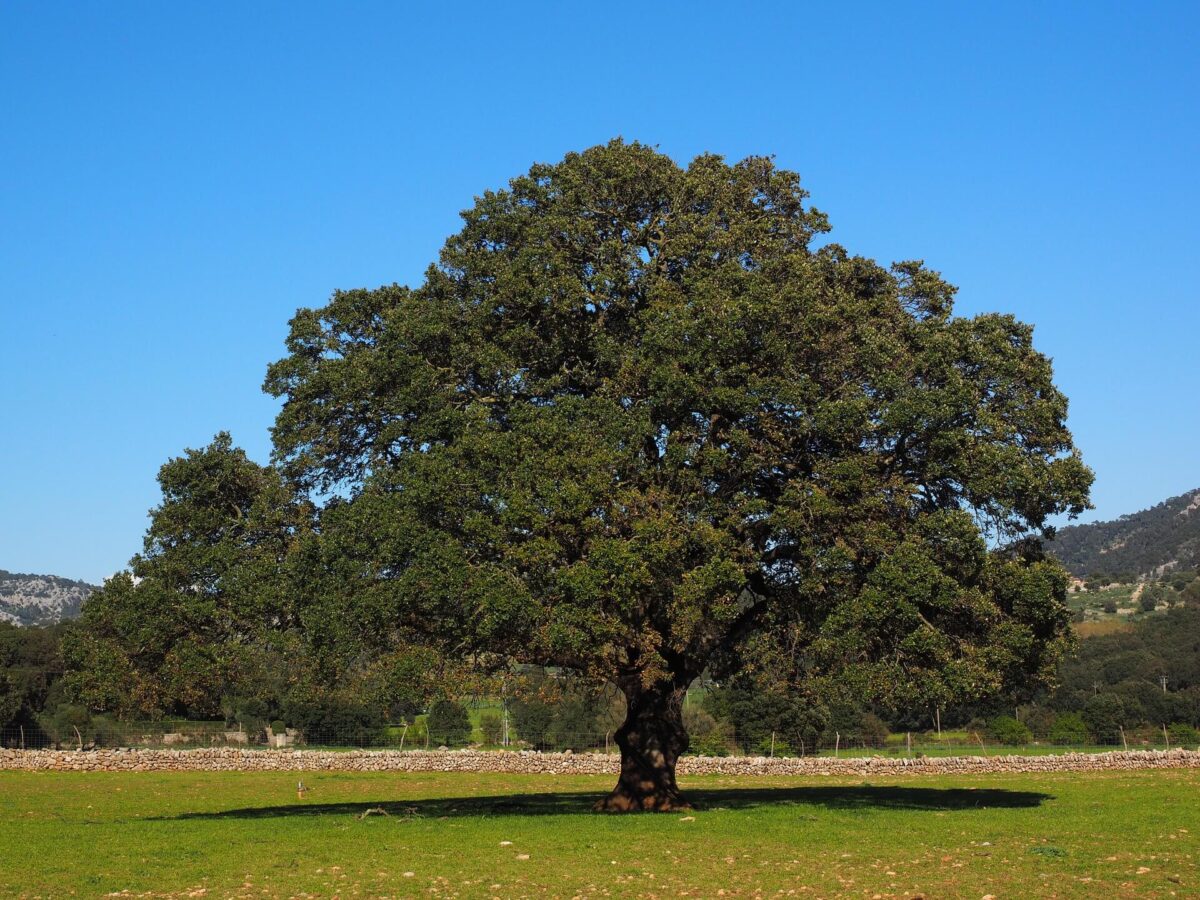
It’s small flowers bloom on three-inch-long panicles and are a greenish white to pale yellow color. Small, dark-blue to black berries appear in the spring, and are irresistible to birds. Although most camphor trees reach heights of 25-50 feet, a few rare specimens have grown up to 100-feet tall.
Table of Contents
A Brief History – Cinnamomum Camphora
The Camphor Tree was brought to the American South in 1875 and planted on plantations, where it was grown for the same purpose: harvesting the strong, odorous camphor oil from its leaves and bark.
Cut a stem or crush a leaf in your hands, and you will immediately notice the strong aroma of the camphor oil. The oil is distilled using steam, and is used as a liniment, or balm, in products like Tiger Balm and is a mild pain reliever used in certain medicines. It also works as an insect repellant and to relieve chest congestion and inflammatory conditions.
The leaves, bark and wood of camphor tree are used in traditional medicine, but they should not be used internally without proper medical supervision as they can cause serious side effects.
Camphors are also incredibly long-lived trees. The best examples of these ancient wonders are in their native land of Japan. The Shoren’in Shrine in Kyoto boasts a camphor tree that is several hundred years old, and is labeled as a city-designated natural monument. Another camphor at Yamada Shrine in Tottori is considered sacred by people in that area because it was reportedly planted more than 1,000 years ago. The oldest camphor in Japan, however, maybe the giant specimen at Kawago in Takeo City. This behemoth is the country’s fifth-largest tree and is supposedly more than 3,000 years old.
Not only are these amazing trees long-lived, they are also capable of surviving the worst that man can throw at them. In 1973, Japan named the camphor the official tree of Hiroshima in commemoration of those trees that miraculously recovered from the U.S. atomic bombing of the city. As these trees sprouted new leaves and bark, they also gave people hope to begin rebuilding their lives.
Camphor Laurel versus Cinnamomum Camphora
Camphor laurel and Cinnamomum camphora refer to the same species. Camphor laurel is a common name for Cinnamomum camphora. There is no difference between them; “camphor laurel” is simply one of the common names used to refer to Cinnamomum camphora, alongside others such as camphor tree.
Camphor Tree Berries
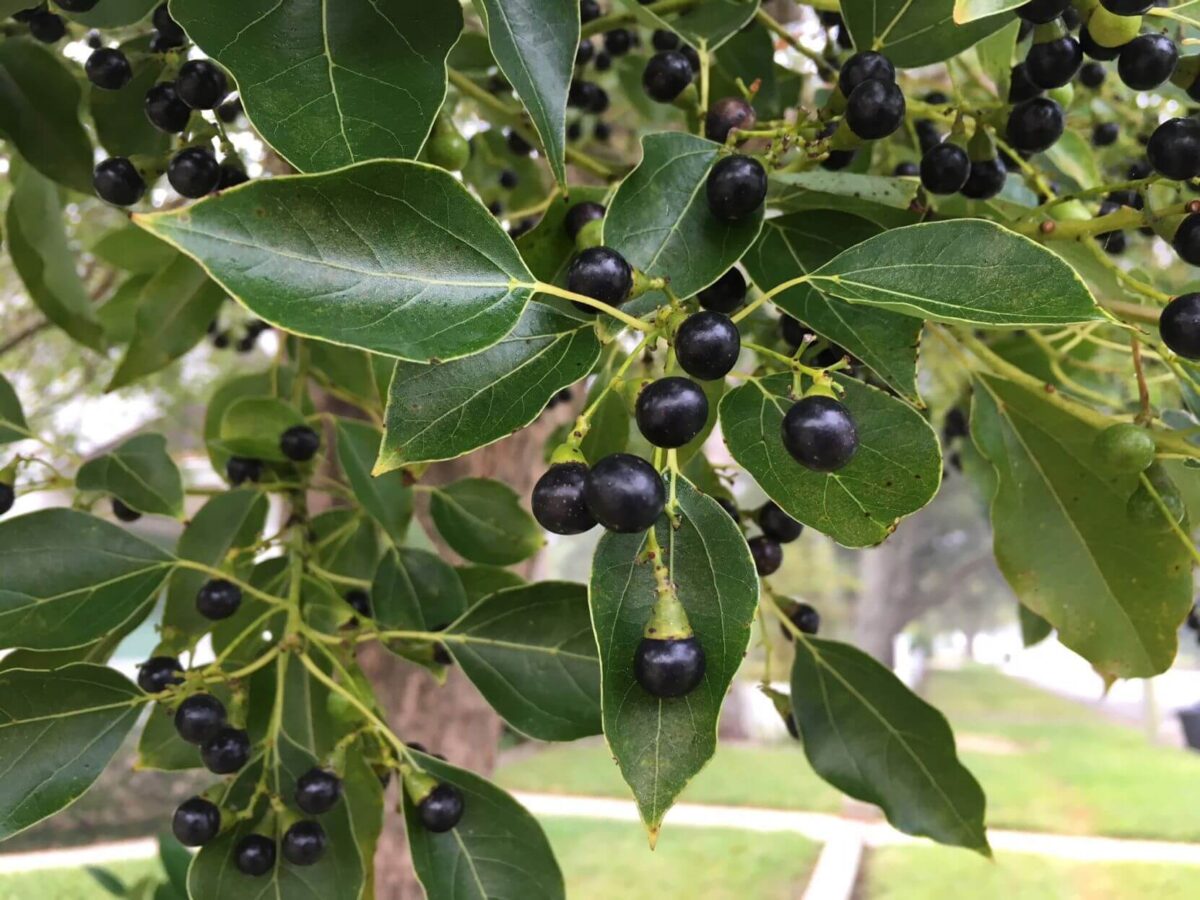
Thought to be camphor tree berries, these are drupes. While not edible to humans, birds love feasting on the ripe fruits.
Camphor trees, despite common misconceptions, do not bear berries but produce drupes. These small, black or brownish-black fruits, roughly the size of a pea, emerge following the tree’s flowering phase. The flowers themselves, often overlooked due to their small size and subtle green or white hues, precede the formation of these drupes. While these fruits may not catch the human eye as a culinary delight, they play a crucial role in the ecosystem, particularly for avian species.
Birds, in contrast to humans, find camphor drupes irresistible and often feast on them when ripe. This interaction highlights a fascinating aspect of the camphor tree’s role in its habitat, serving as a vital food source for various bird species. The drupes’ inedibility to humans underscores the diverse and specialized diets within the animal kingdom, where what may be toxic or unpalatable to one species is a treasured resource for another.
The presence of these drupes on camphor trees also serves as a reminder of the tree’s reproductive strategy. Unlike plants that rely on visually appealing fruits to attract human and animal consumers for seed dispersal, the camphor tree has evolved to cater specifically to birds. This relationship not only aids in the dispersal of the camphor tree’s seeds but also supports the dietary needs of the birds that partake in these fruits.
By providing essential nourishment to birds, these drupes facilitate a mutualistic relationship, ensuring the continuation of both the camphor tree species and the avian populations that rely on them. This intricate interplay between flora and fauna exemplifies the complex web of interactions that sustain biodiversity.
Camphor Tree Leaves
Camphor tree leaves, with their glossy, evergreen appearance, play a pivotal role in the tree’s ecological and cultural significance. Characterized by their strong, aromatic scent, emerge as a focal point of interest for both botanists and enthusiasts alike. Each leaf, oval-shaped and leathery to the touch, not only contributes to the tree’s aesthetic appeal but also serves as a powerhouse of biological activity.
The process of photosynthesis in camphor tree leaves showcases a remarkable efficiency. These leaves harness sunlight, converting it into chemical energy with a proficiency that sustains the tree’s growth and supports its surrounding ecosystem.
The camphor contained within the leaves holds a treasure trove of uses. People extract this compound for its therapeutic properties, utilizing it in medicinal and aromatic products. This extraction process, which involves distilling the leaves, taps into the ancient practices that have revered the camphor tree for centuries.
The leaves serve as a habitat and food source for various wildlife species. Insects and birds, drawn to the camphor tree’s canopy, find shelter and sustenance among its leaves. This interaction highlights the leaves’ contribution to biodiversity, supporting a complex web of life that thrives around the tree.
What Does Camphor Smell Like?
Camphor has a unique and penetrating aroma, striking a balance between medicinal and minty with a hint of woody undertones. This distinctive scent, both clean and cooling, makes it a staple in various medicinal and therapeutic formulations.
Its robust fragrance, often associated with cleanliness and freshness, finds its way into ointments, inhalants, and topical pain relievers, offering relief and a sense of rejuvenation.
Beyond its health-related applications, camphor’s aroma plays a significant role in spiritual and aromatic practices worldwide. Its invigorating scent purifies environments, creating spaces that feel both sanctified and invigorated.
This aroma does more than just please the olfactory senses; it also contributes to camphor’s longstanding value in cultural and healing traditions.
The scent of camphor is often used in products such as chest rubs, liniments, and medicated balms as it is believed to have decongestant and anti-inflammatory properties.
Invasive Camphors
Unfortunately, there are major downsides to this wonderful tree. The Camphor tree is considered a Class 1 invasive pest in Florida and Texas, which makes it incredibly harmful to those environments. It is spread rapidly by birds eating the camphor berries, and is tough to get rid of, allowing it to easily displace other native shrubs and plants. One such plant is the endangered Florida jujube (Ziziphus celatus), a native species in Florida that is being pushed out by the camphor tree.
Getting rid of a camphor tree can be a difficult task due to its size and hardiness. There are several methods that can be used to remove a camphor tree, including:
- Cutting: Cutting down a camphor tree is the most common method of removal. However, this method is not recommended as it can result in the tree sprouting new growth from the stump.
- Chemical treatment: Using a herbicide, such as glyphosate, can effectively kill a camphor tree. However, it is important to carefully follow the instructions on the product and take necessary precautions.
- Root Removal: Excavating the soil around the tree and removing as much of the root system as possible can effectively kill a camphor tree. This method is labor-intensive and requires heavy equipment.
- Preventive measures: One of the most effective way to prevent camphor trees from growing is to mow or pull young saplings before they become established.
It is important to note that before attempting to remove a camphor tree, check with your local authorities to see if there are any regulations or laws in place regarding the removal of trees in your area. Additionally, consider consulting an arborist or other tree care professional to determine the best course of action for your specific situation.
Fast Growers
Camphor trees will grow rapidly their first few years, then slow to 24 inches per year beyond that. In my own yard, I’ve found camphor trees grown from birds dropping their seeds to grow from seed to 4-5 feet in several months. Because camphors are fast-growing and can grow quite large, you should think twice before planting a camphor close to your house, garage, or on a small lot.
If you have one in your yard, it’s best to watch for any “strays” that pop up elsewhere in your yard. Be sure to remove each and every root of a camphor tree if you want to be sure it won’t re-grow in the same spot. Otherwise, you will end up with your own Camphor tree plantation.
Camphor Tree Problems
Camphor trees encounter various challenges that can affect their health and longevity. These are some common problems along with insights into their causes and implications.
Root Invasion: Camphor trees possess an aggressive root system that often ventures far beyond the tree’s canopy. This relentless quest for resources can lead to conflicts with nearby infrastructure. Sidewalks, driveways, and even foundations of buildings may buckle or crack under the pressure of these invading roots. The problem not only poses a risk to the tree’s immediate environment but also to the tree itself, as it may become destabilized or deprived of nutrients in densely populated areas.
Pest Infestations: The camphor tree’s lush foliage attracts a variety of pests. Among these, the camphor shot borer poses a significant threat. This beetle targets weakened or stressed trees, boring into their trunks and branches, which disrupts the tree’s ability to transport water and nutrients. The infestation can lead to branch dieback, reduced growth, and in severe cases, the death of the tree. Managing these pests requires vigilant monitoring and, when necessary, intervention with environmentally sensitive pest control methods.
Disease Susceptibility: Fungal diseases, such as sooty mold and root rot, frequently afflict camphor trees. Sooty mold, while not directly harmful to the tree, covers the leaves with a black, powdery substance, impairing photosynthesis. Root rot, on the other hand, attacks the tree’s foundation, decaying its roots and often leading to the tree’s demise. These diseases thrive in moist conditions, making proper drainage and spacing essential for the health of camphor trees.
Allelopathy: Camphor trees exhibit allelopathic properties, releasing chemicals into the soil that inhibit the growth of surrounding vegetation. This trait, while beneficial in reducing competition for resources, can pose challenges for landscaping and biodiversity. The chemical barrier created by camphor trees can limit the variety of plants that can thrive in their vicinity, impacting the ecological balance of the area.
Environmental Stress: Camphor trees, although resilient, are not immune to environmental stressors such as drought, pollution, and extreme temperatures. These conditions can weaken the trees, making them more susceptible to the aforementioned problems. Ensuring adequate water supply during dry periods, minimizing exposure to pollutants, and selecting appropriate planting locations can mitigate these stressors.
Should you plant a camphor tree?
The consensus online is that…well, there is none. People either love them or hate them. I love them because I get to look at two beautiful camphor trees that are growing on my block from a safe distance. I am saved the trouble of keeping up with their pruning, and I don’t have to deal with constantly pulling pesky camphor “minions” that pop up.
So, my cautious advice is to only plant a camphor if you have the space, time and money to take care of one. Plant one – just one – in the largest space in your yard, where it’ll give you the most amount of shade in the summer. After you’ve planted it, have a professional inspect and trim your young tree to ensure it ends up as a manageable, yet beautiful shade tree.
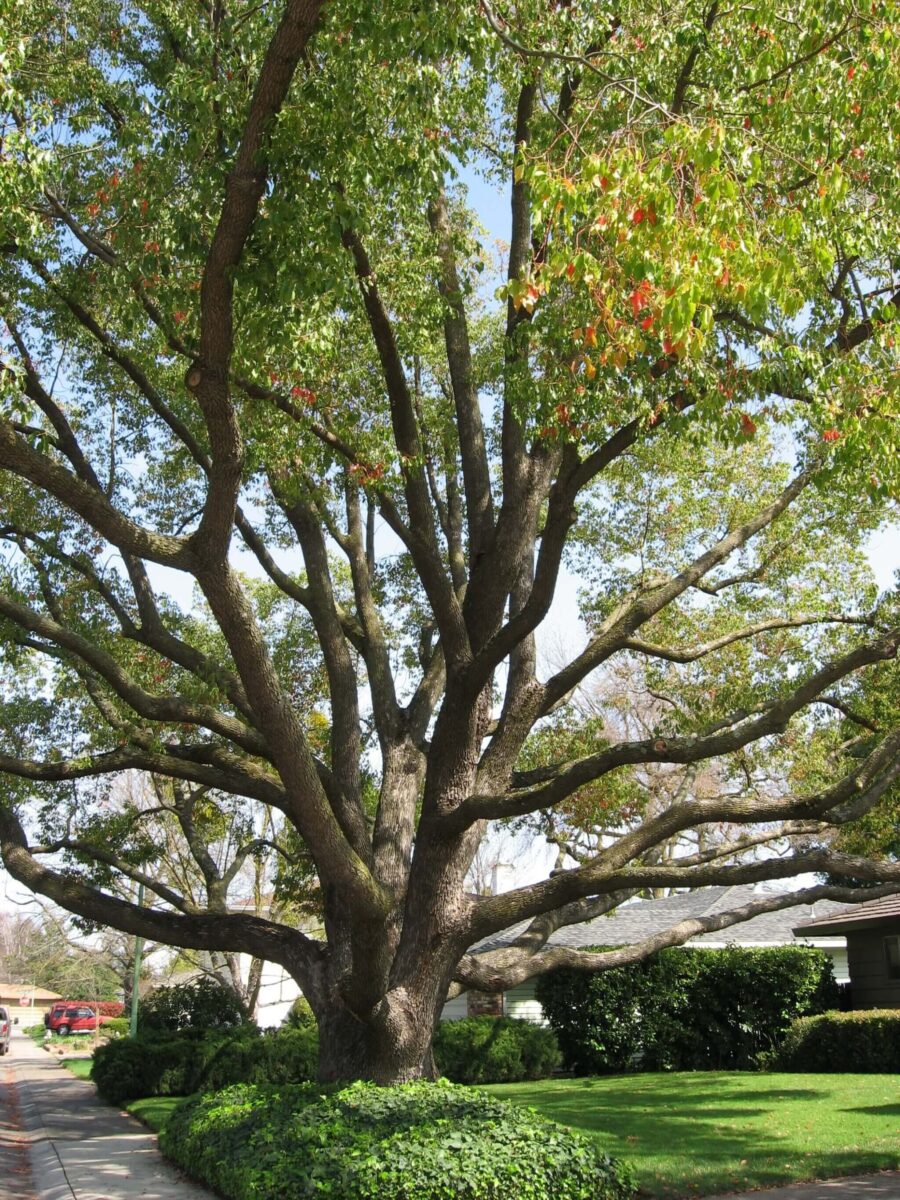
Pruning your Camphor Tree
Your camphor will require some regular trimming when it’s young and only occasional attention as a mature tree. Trimming low branches when it’s young will result in a more compact, manageable canopy in the future. Otherwise, the tree will develop a much more open, wide-spreading canopy that has the potential of drooping significantly.
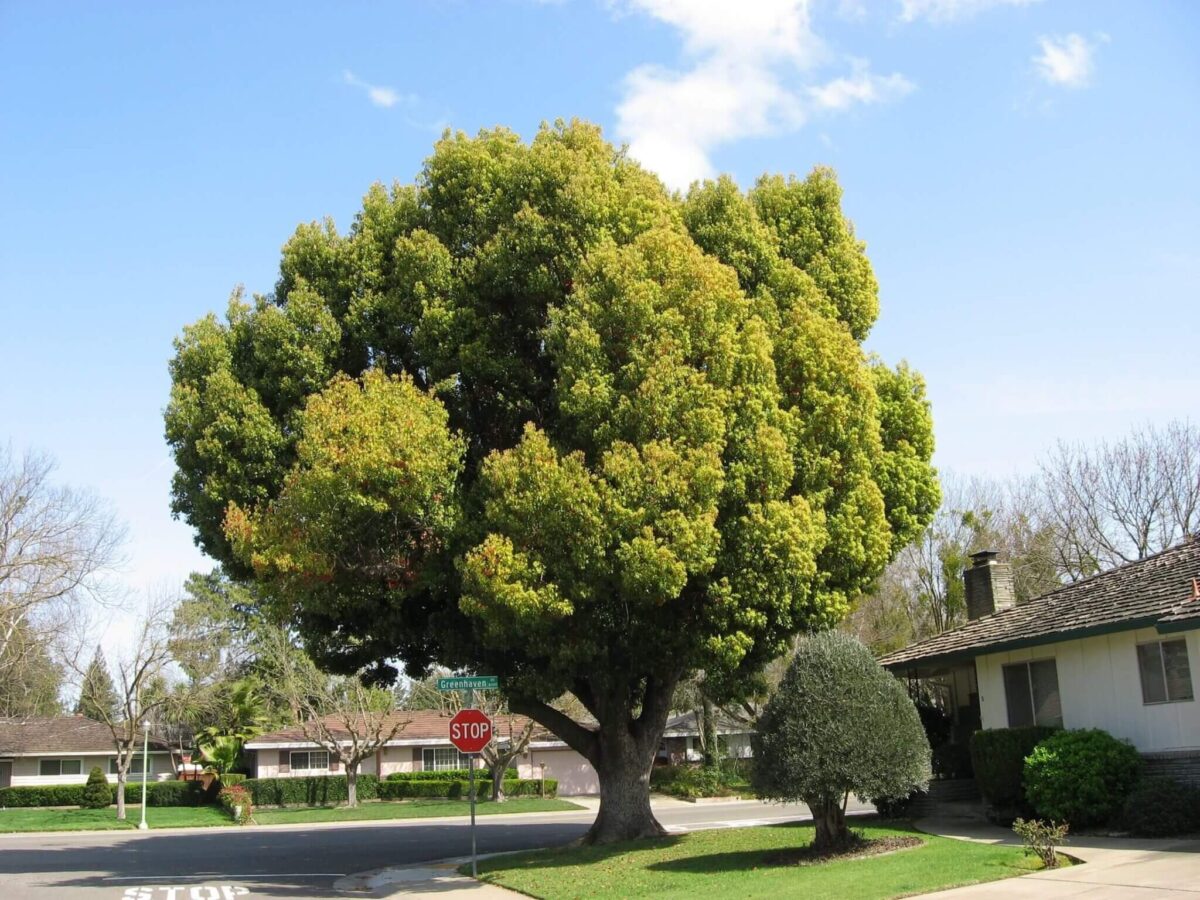
Cut branches back to where they originate, making sharp, clean cuts flush next to the stems with sterilized pruning shears, as to not spread disease. Pruning branches growing near the base will help develop a single and strong main trunk. Then, prune branches growing on the trunk so one stands every 18 to 30 inches apart.
You can remove damaged or diseased branches from an older camphor at any time of year, and if your tree is outgrowing a small space, simply prune it back in the winter to control its growth. Topping, or blunt cutting your camphor tree is not a good idea, as it will result in far more dead branches likely to fall in the future.
Constant trimming with a chainsaw can result in more problems down the road, and there are instances when careful, professional trimming is in order. Call someone who knows what they are doing so you end up with a safe and healthy tree.
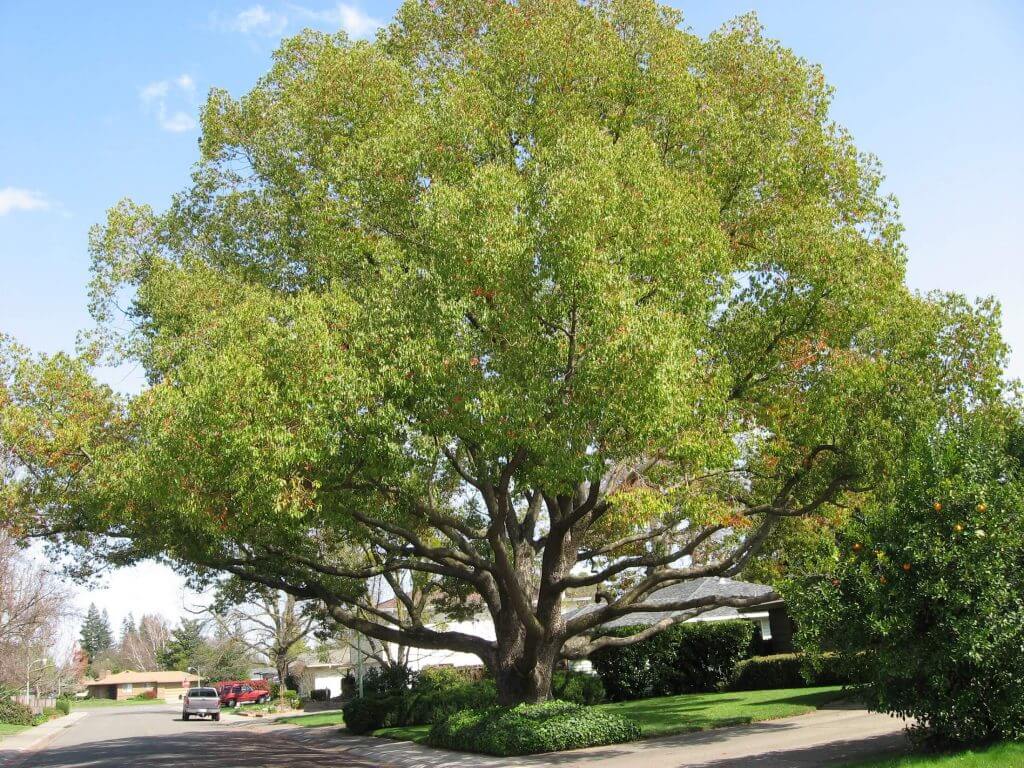
How to Grow Camphor Trees
Tree Site Conditions & Constraints
- Sunset Zones 8, 9 and 12 – 24.
- USDA Hardiness Zones 9 – 11.
- Exposure Full Sun to Partial Shade.
- Moist Soil.
- Clay, Loam or Sand Texture.
- Slightly Acidic to Highly Alkaline Soil pH.
- Salinity Tolerance is Moderate on Coast.
- Seaside Tolerance is Good in Mild Zone.
Pests & Disease Information
Susceptible to:
- Anthracnose
- Armillaria
- Phytophthora
- Root Rot
- Verticillium
Health, Safety & Environmental Concerns
- Branch Strength Rated as Strong.
- Root Damage Potential Rated as High.
- Allergy Health Hazard.
- Biogenic Emissions considered Low.
- Fire Resistance is Favorable.
- Attracts Birds.
- Extremely invasive in some parts of the U.S.
Camphor Tree FAQ
Are Camphor Trees Invasive?
Yes, Camphor Trees are invasive to many parts of the world, including Florida, Georgia and Texas. Introduced to Australia in 1822, the weed quickly became a noxious weed throughout Queensland and New South Wales. Camphor trees spread rapidly and prevent native plants in these areas from growing and germinating.
How fast do Camphor Trees grow?
Camphor trees will grow rapidly in their first few years, then slow to 24 inches per year beyond that.
How long do Camphor Trees live?
The camphor tree can live anywhere from 50 to 150 years. Although, there are many old camphors in Japan. One is even reported to be up to 3,000 years old.
Are Camphor Tree berries edible?
No, the berries are toxic to humans in large quantities. Birds, however, love eating the berries.
| Botanical Name | Cinnamomum camphora |
| Common Name | Camphor tree |
| Plant Type | Evergreen |
| Mature Size | 50-65 ft. tall, 50-60 ft. wide |
| Sun Exposure | Full sun |
| Soil Type | Moist, fertile, sandy soil |
| Soil pH | Slightly acidic to very basic |
| Bloom Time | April |
| Flower Color | Inconspicuous |
| Hardiness Zones | USDA 9-11 |
| Native Area | China and Japan |
| Toxicity | Toxic to people, toxic to cats, toxic to dogs |
Pin This!
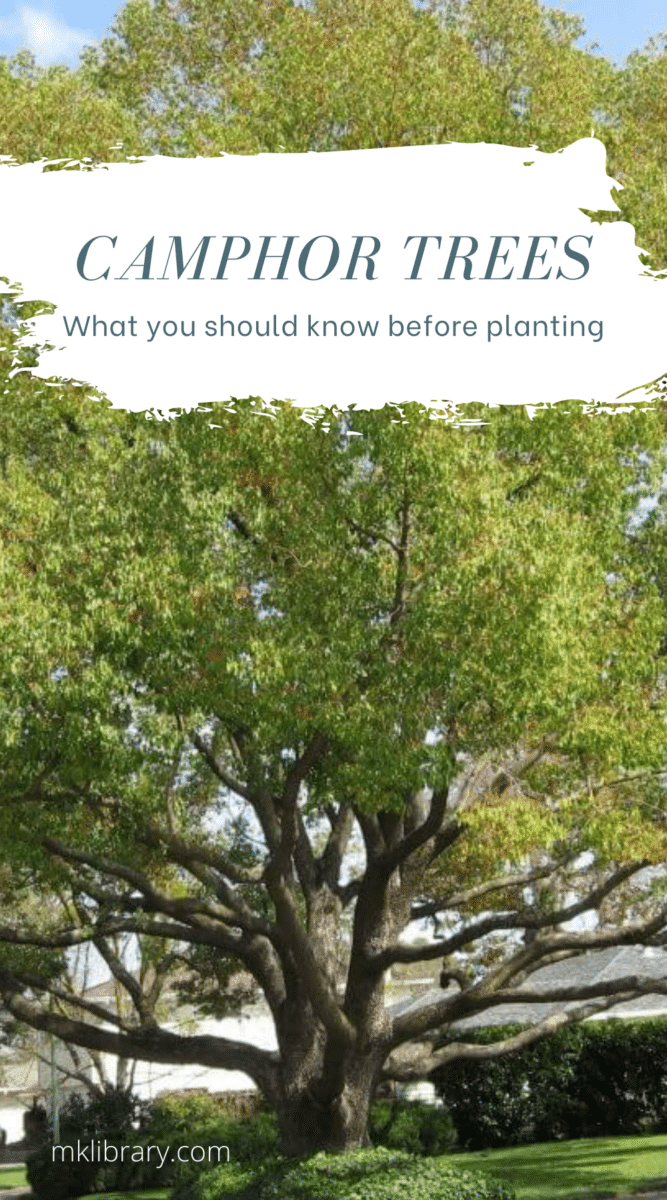
- About the Author
- Latest Posts
I strive to paint vivid landscapes with my words, bringing the magic of far-off lands and enchanting aromas to life for my readers. Combine passion for exploration and the art of gastronomy in an unending ode to the senses. When I’m not traversing the globe, I find solace in the earth beneath my fingertips, tending to my garden and working on projects around my verdant oasis. MK Library serves as a beacon, guiding fellow travelers and homebodies alike to embrace sustainability, nurturing both our planet and our souls with purpose. Full Bio.



Hi,I just had a company removed both of are Camphor trees that was 30 ft tall,after removing they grinded the stumps and now the smell on our backyard is really strong, should we be worried with our health?
I have 3 camphor trees in my ysrd snd they are doing very well, but ii seem to have a constant leaf drop.
Is this normal ?
Yep, that is pretty normal for the camphor trees. The oils from the leaves will suppress growth of plants around them, so you’ll want to keep your yard tidy for the most part.
Very normal. I live in Savannah GA and my front yard has 50 ft high Japanese Camphor, and it sheds leaves pretty much year round …sort of the same way a Live Oak does.
Thanks for this column, Mr. Mike! I have hundreds of camphor trees and seedlings of all different sizes on .34 acre. I wanted to develop the land, but learning about how camphor trees are invasive, take over (which they already have) and damage septic systems, I am thinking of selling the property. My question: If I have the lot cleared and all stumps removed, and fill added to bring the property elevation up, will that kill any seedlings that remain in the soil, if they are under the a couple feet of fill?
Hi
Can we make bonsai of camphor tree
NPS
I just endured Hurricane Michael this past fall, and it wiped out about 80% of our trees. The only ones left standing are some native pines, landscaped crape myrtles, landscaped palm trees, and then the camphors. I have two in my yard three in my yard that are standing tall and strong and two babies (sprouts only a couple feet). The storm took 17 of my 21 trees (including my beloved cedar and some gorgeous shade tree), and I’m not keen on removing the three well-established camphors. On the other hand, those sprouts I was considering transplanting (since one’s near my septic and one’s literally touching the house). Should I not transplant these baby trees since they’re invasive? I desperately need shade and my area desperately needs trees fast, but I want to be responsible. Anyone have any advice for me? Also, since it’s Class 1 Invasive Species, is it something illegal to even intentionally plant in Florida (thus illegal to transplant)? Thanks in advance for any guidance!
Plant moringa, it grows fast and has many uses.
Please! Never plant a camphor tree!!! This is the most invasive tree, our property is overrun with seedlings everywhere, the ones that have grown on the vacant property nearby, actively try to kill the slower growing native trees by choking out their sunlight. In ten years time a camphor can kill a native live oak tree, and we fight to keep them cut back all year long here. Our native insects don’t feed on camphors, so there are fewer birds around too. There are thousands of these trees that sprout every year, all year long here, (South Alabama), and now they are in the woodland areas. Yes, it’s a beautiful tree, but it belongs in its native land.
Thanks for stating the truth Diane. It is frustrating that MK is recommending planting them when they are invasive & are outcompeting native flora. How could any educated person do this? It is infuriating!!!
I bought a home in Fla. with a Camphor tree in the front yard about20/25′ from the house. It’s a lovely tree pruned to a more upright tall than a large wide spread. I’m concerned about the roots and closeness to the house, but I don’t want to cut it down as it gives valuable shade.
Suggestions?
We have a 70-year-old camphor here in California that has cost us thousands of dollars in plumbers over the past 12 years due to roots invading the sewer line. Just learned that the roots have now gone under the house into the backyard vegetable beds. Seems implausible, but a quick smell of the roots in backyard and front yard confirmed it. Get rid of your Camphor Mary. Gorgeous Asian tree best left in it’s native land.
There seems to be two types of Camphor trees in Florida, one grows to be quite large and the other type doesn’t grow much over 15 ft, and has a different bark, have you heard of this
It is my favorite wood to turn on the lathe.
We have two camphor trees in our yard. We planted one 17 years ago, and it is beautiful. They are grate for shade. We planted another one 3 years ago, and it’s taller then me now, and I’m 5’10. My grandmother also has one in her yard, and she told me when they bought that house over 60 years ago, that tree was already there. It’s very old, and still beautiful. When it says take care of the little ones that growing, you need to, because once it starts, and the root gets to long, will not be able to get rid of it. You have to have a big yard, to plant one of them.
Is camphor any good to use in a fireplace as a heat source?
I have a tree about 6 feet tall. It’s trunk & branches are dark green. My neighbor says it’s a Camphor tree. Are they right?
I just bought 2 young trees about 10′ and yes their bark is green.
I recently visited Galveston Island to visit some of the art galleries. I found a number of wooden sculptures that were sculted from camphor. The wood had striking colors that really made it stand out. When I asked about the type of wood, and was informed that these pieces were all carved from the camphor trees that were victims of huricane Ike. I thought the pieces were beautiful and wondered if this wood is conside and hard or soft wood and does anyone make furniture from this wood.
Thanks,
Bill